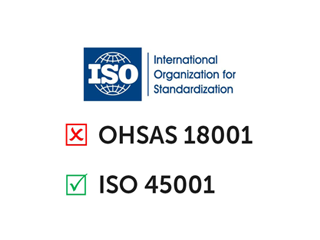EHS: is 45 the new 18?
06 Feb 2018
Health & Safety

OHSAS 18001 is finally being brought under the wing of ISO, the international standards setting organisation. However, it won’t be conveniently renamed ‘ISO 18001’ as that’s already in use. EHS Unit Director, Jim Clifford, provides an overview of the new standard.
ISO 45001 was originally expected in 2016, but is finally due for release in March 2018. With poor health and safety management estimated to cost around 4% of global GDP, will the new international standards impact have the potential to save lives, reduce accidents, improve employee morale and deliver stronger financial performance?
The new standard has been through a number of draft iterations where key stakeholders contributed to the direction of the standard before publication, providing an even greater emphasis on ill-health prevention than the last revision of OHSAS 18001.
Whilst many elements are taken from OHSAS 18001 (and there are similarities) it is important to note that ISO 45001 is a completely new publication. Typically when standards are revised, organisations have a transition period, to affect the changes. Initially it was thought as a brand new document that the transition period wouldn’t apply. However, following deliberations over the last two years, it has been recognised that current holders of OHSAS 18001 should be allowed the three-year window to successfully complete the transition to ISO 45001.
ISO 45001 utilises the same common structure, definitions and core text being used for the latest versions of ISO 14001 and ISO 9001, the environmental and quality management system standards. This is in line with ‘Annex SL’ - the rules governing the development of all ISO management standards. This will mean the structure of the new standard includes:
- Scope
- Normative references
- Terms and definitions
- Context of the organisation
- Leadership
- Planning
- Support
- Operation
- Performance evaluation
- Improvement
For current holders of OHSAS 18001, these changes will mean there are material differences between old and new which will need to be addressed. However, those wanting fully integrated HSEQ management systems to all three ISO standards will find it simpler and easier due to the greater clause alignment. Even implemented as a standalone HS system, ISO 45001 has the potential to improve safety performance and ultimately reduce accident rates.
Some organisations will be looking to transition existing management system to ISO 45001 and others may be looking to introduce the standard as a new concept. Delta-Simons has the team, competence and experience to assist clients across a wide range of sectors and industries with the development and implementation of a ISO 45001 compliant safety management system.
Please contact Jim Clifford at jim.clifford@deltasimons.com if you require further information. See all our Compliance services.
Related article: How the tech sector implements EHS



